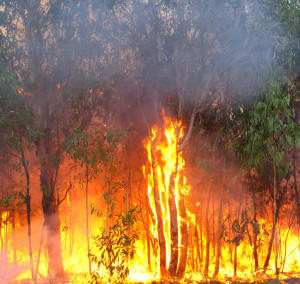Preparing Your Property for the Bushfire Season
September 17, 2013 - 4 minutes read We all know in Australia that the summertime is bushfire season, and good preparation is the key – ideally well in advance of the warmer months.
We all know in Australia that the summertime is bushfire season, and good preparation is the key – ideally well in advance of the warmer months.
Preparation involves more than just emergency procedures of course. Factors such as property maintenance, good landscape design, and regular rubbish removal can all greatly contribute towards decreasing the risk of property loss and injury or death from fire.
Bushfire risk factors
Apart from heat and dry conditions, there are a number of factors that increase bushfire damage risk:
- Sloping topography – according to the Country Fire Authority (CFA), a fire will travel twice as fast for every 10 degrees of upwards slope. This increase in speed also leads to greater levels of intensity and heat.
- Dry vegetation – grass, leaves, twigs, bark, and branches.
- Plant selection – flammable plants are naturally more likely to ignite.
- Wind – strong winds increase the oxygen level which then leads to greater fire intensity. Wind also determines the speed at which a fire travels and can carry hot embers – leading to spot fires or fire entering a building.
Reduce the risk
- Create a defensible space of about 30 metres around the building. This area should be free of flammable materials such as stacks or piles of wood or debris, dead vegetation, highly flammable plants, flammable liquids, and any other items that are likely to ignite during a fire.
- Mow or slash the grass, and keep it short – ideally less than 10cm. Grassfires can spread incredibly quickly.
- Create space between plants to reduce the risk of fire spreading from one to another.
- Make sure any outdoor machinery you use is in good condition and not likely to spark a fire.
- Prune shrubs, cut back branches, and clear gutters of vegetation and debris.
- Avoid flammable mulch in garden areas. Use rocks / pebbles instead.
- Make sure mature trees are well-cared for. See our guide for tree maintenance here.
- Plant wisely. While all plants carry a risk of igniting some are more at-risk than others (see below).
Wise plant selection
As mentioned above any plants can ignite, but by planting wisely you can reduce the risk of this happening.
High-risk plants – these include trees with coarse or fibrous bark such as some stringybark varieties, grass plants taller than 30cm, and plants that retain their dead twigs and leaves rather than shed them.
Moderate-risk plants – include trees with low-lying branches, conifers, trees with papery bark such as Tea Tree, fine-textured plants, coarse-textured plants with dense foliage, and plants with waxy leaves that contain volatile oils.
The above is a general guide only. For more detailed information, see the CFA’s Plant Selection Key.
Burning off
Burning off vegetation or undergrowth may be permitted as long as it is not done during the fire-danger period – that is unless you have a written permit from a Fire Prevention Officer.
However any burn-offs should be registered with ESTA (Emergency Services Telecommunications Authority) on 1800 668 511. Of course it’s also important to look into any restrictions from your local council.
Before burning off you should notify the neighbours, set up a 3m fire-break, and ensure that there are sufficient people on hand to monitor and contain the burn.
Keep up the maintenance
Lastly, regular repairs and maintenance of your building reduce the risk of stray embers from entering into it and increasing the risk of major damage and personal injuries. Make sure to look after your roof in particular – see our article on roof maintenance if you require more information.
Written by Tess Oliver
Tags: fire, weather
Recent Comments